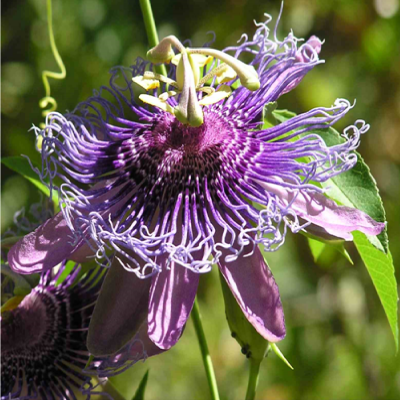Passion flowers (genus Passiflora), so called because the flower structure is interpreted by some to symbolize the passion of Christ, are mainly tropical South American plants with about 350- to 400 species. The flowers occur on climbing vines. Thirteen species occur in North America, and three species are native to Arizona. There is some indication that an Arizona species is carnivorous.
I took the photo below at the Arizona Sonoran Desert Museum. The plant occurs near the art gallery. It is Passiflora incarnata or incense passion flower. The flower is about five inches across.
Passiflora incarnata, which occurs mainly in the southeastern U.S. and the tropics, was used as an herbal medicine to treat nervous anxiety and insomnia. There is some clinical evidence that extracts of this plant can successfully treat withdrawal symptoms from alcohol, morphine, nicotine, and cannabis. Medline Plus gives additional information.
The Arizona passion flower (Passiflora arizonica) is much smaller, only about one to two inches across. See “Southeastern Arizona Wildflowers” for photos and a description. Arizona Game & Fish Department has a detailed description here. The two other Arizona varieties are Passiflora mexicana (which smell like mothballs) and Passiflora bryonioides.
The Arizona passion flower produces fruit about one inch in diameter, which go from green to yellow to red. According to Southeastern Arizona Wildflowers, these fruits are edible, but contain little pulp. Another name for the Arizona varieties is “fetid passion flower” because crushed leaves give off a fetid smell. The leaves and other green parts of the plant are poisonous. “This unusual passion flower may be carnivorous, or at least protocarnivorous (on the evolutionary path to becoming carnivorous in the future). The bracts surrounding the flowers and fruit have glands that secrete both a sticky fluid to trap insects and digestive enzymes to digest them.”
Writing more generally of passion flowers, Botany.com says: “Some varieties [including the incense variety] produce edible passion fruits, which vary in shape and size. They contain a jelly-like pulp embedded with numerous seeds. These fruits are only produced where the summer-time temperature is a minimum of 60º F.”
Passion flower vines generally bloom from May to December.
See also:
Yuccas provide food, fiber, and soap
The Jojoba bush and its valuable oil
Mesquite trees provide food, fuel, medicine, and more

